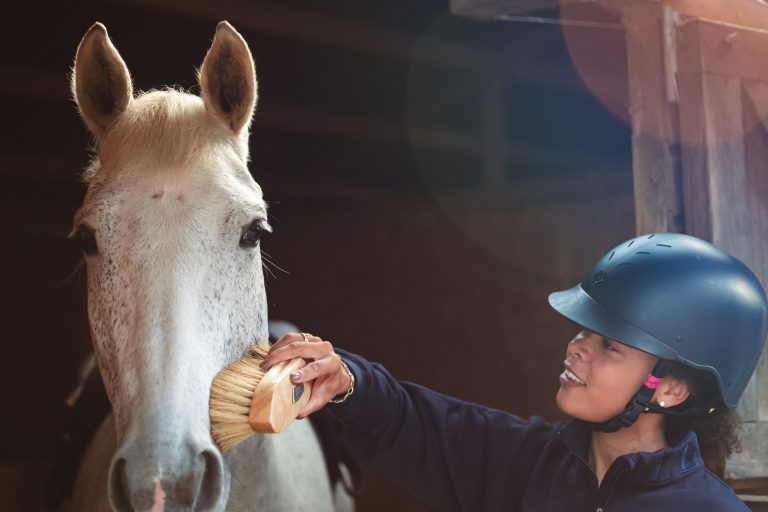The freezing temperatures, knee deep mud, dark nights (and mornings!) and fresh, stable bound horses are just some of the delights that horse riders can expect as we head into the winter months. But it’s vital to find ways to make life easier for you, your horse, and around the stables.
Luckily, there are a number of tips and tricks that can help. So, buckle up as we explain a few useful tips for the chillier season.
Around the paddocks
If there’s one key piece of advice for horse riders this winter, it’s to plan ahead. There’s always an unpredictable element to horse riding during the winter months, so being prepared for every eventuality will stand you in good stead.
Firstly, keep an eye on your weather app! Knowing what temperature to expect will help to rug horses appropriately and avoid them getting too hot or too cold overnight.
Secondly, have salt ready for the first freeze, so that your horses and cars aren’t sliding around on the yard. It could be very dangerous to move around without some extra grip.
And lastly, when the temperatures drop below zero, the taps can struggle and pipes can freeze up. Preparing water buckets the night before is a sensible option and means you can keep the horses hydrated even when the taps are out of order.
The right nutrition
Being aware of and adjusting feed in relation to turnout and workload is crucial to keeping horses sane. Providing enough forage is crucial, helping to satisfy their needs, especially when grass is not as readily available. It also helps horses keep warm, due to the way their digestive system breaks down the fibre.
However, it’s important to get the amount right. If horses are staying in for extended periods of time be sure to cut down their hard feed, as you’ll have happier and more manageable horses.
Horse owners across the UK are facing a significant challenge: the cost of forage – particularly hay and haylage – has risen sharply due to a combination of environmental and economic pressures.
For many, this means a steep increase in winter feeding costs. A single horse can consume over 150 small bales per year, translating to £750+ annually just for hay – before factoring in waste. With up to 30% of hay lost to trampling or spoilage, the real cost can be even higher.
What can you do?
- Secure forage early: Build relationships with local suppliers and order in advance.
- Reduce waste: Use slow feeders, haynets, or hay hutch systems to stretch every bale.
- Explore alternatives: Consider fibre feeds, beet pulp, or chaff-based products, but introduce them gradually and with nutritional guidance.
- Plan your pasture: Maximise grazing where possible and manage high-traffic areas to preserve ground quality.
- Budget wisely: Calculate your winter needs now and explore storage options with suppliers.
The rising cost of forage is a reminder of how closely horse care is tied to farming and climate conditions. With preparation and smart feeding strategies, owners can help ensure their horses stay healthy and well-fed through the colder months.
For the rider
Of course, it’s not just your horse affected by the cold – you will be too! That’s why a good set of thermals and over trousers will make an enormous difference and help keep away those chilblains. Footwear is another key area of clothing, as cold wet feet should be avoided at all costs!
Remember, you need to look after yourself, as well as your horse, to keep both of you safe and happy throughout the cold, winter months.
Warming up
Of course, a drying room is ideal for warming up and drying off equipment after a cold or wet ride. But we don’t all have that luxury!
If your horse is warm and dry under their wet turnout rugs, you can leave them on for a couple of hours. Their body heat will soon dry them for you.
Bedding down
Making the perfect bed for your horse is such a satisfying activity. When it’s all swept back with nice level banks, we’ve all had that moment of glee. And now that the weather has turned much colder more horses are being brought into stables overnight. Creating a comfortable environment is vital for their health and wellbeing.
But with so many types of bedding to choose from it’s important to consider which would work best depending on your horse’s stable habits. And there’s been a lot of discussion in recent years about the environmental repercussions of using particular bedding types. If we wish to enjoy the outdoors, which is at the core of our sport, we must look after it and protect its future.
One option is to choose a material that’s already a natural byproduct of modern-day farming, such as UNIBED. As an affordable, straw based product, it’s truly one of the best options for messy horses especially, absorbing and retaining all moisture, and rotting down efficiently. This results in smaller muck heaps, which can be spread straight back onto the land, creating a perfect cycle!
If you would like to talk to our equine insurance specialists call the team directly on 01743 455911. They will be more than happy to answer any questions you may have.

